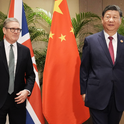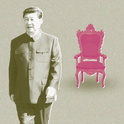Away from the daily news about America’s spats with China over trade and technology, we know one thing at least: the world’s two biggest economies are locking horns for the foreseeable future and, like it or not, the rest of us will be drawn in. We are witnessing a sharp divergence in the ways of the world. On one side is China’s model of authoritarian state capitalism in a Leninist structure with the Communist Party at its heart. On the other, a western model still not fully recovered from the financial crisis, but one based on liberty, individual freedom, and the rule of law.
In last month’s Prospect, Kerry Brown assessed Australia’s challenging relationship with China and described a country caught between Beijing’s interference and Donald Trump’s weakening commitment to Canberra. Brown’s conclusion—Britain should set the terms for its engagement with China, unless it wants Beijing to do so unilaterally. Isabel Hilton’s article, also last month, considered the ways in which “Xi Jinping Thought” has permeated Chinese media, society, business and commerce. As the Party tries to persuade other countries to follow its political and cultural model, often by clandestine methods, she wonders whether we have even started to think of the consequences should it succeed.
Xi’s China has indeed performed a remarkable shift. A radical change in government structure was unveiled at the 19th Party Congress last October and approved by the National People’s Congress in March. The changes aim to make Xi’s command more disciplined and effective as he, at the head of the Communist Party, pursues the struggle to realise the “Chinese Dream,” or the nation’s “great rejuvenation.” But while there is no doubt that China is surging onwards, it is heading towards a politically uncertain end.
In its foreign policy, China’s behaviour is consistent with that of a regional hegemon, and an aspirant global power. Its signature policy is Xi’s Belt and Road Initiative (BRI). Dressed up as a Eurasian development project, and sometimes likened, incorrectly, to the US Marshall Plan after the Second World War, the BRI is much more a China-centric strategy designed to confer economic and geopolitical benefits.
The BRI is intended to cement China’s position as the world’s biggest export hub, while plugging it into the middle eastern and Eurasian oil and commodities it so needs. It will also edge China towards maritime and military control of the East China Sea, which includes Taiwan, and also the South China Sea, which carries about a third of global sea-borne trade. The BRI will also encircle India via port and naval facilities from Southeast Asia via Bangladesh and Pakistan to the Horn of Africa.
The BRI will bring infrastructure to poor regions and capital-hungry nations. Yet it will also bring large debts to countries with limited ability to repay. According to one recent study, the peculiarities of Chinese rather than multilateral agency financing threaten 23 countries with some form of financial distress, and eight with debt sustainability issues. Disputes over financing conditions and control of projects linked to the BRI have caused some countries, including Sri Lanka, Pakistan, Kenya and Tanzania to cancel or suspend projects.
Kishore Mahbubani opined in Prospect last month that the “meritocratic” Communist Party should be trusted as a bulwark against Chinese nationalism and to deliver global public goods.
Yet this sanitised version of China’s place in the world is a far cry from the reality. At home, the strengthening of the Party’s position within the governance structure and the establishment of Party representation in both state and private enterprises make for a very different business environment. Top-down, politically-set targets for key sectors in advanced manufacturing and technology could hinder China’s ambitions to achieve global technological supremacy. And the claim that China’s model of digital authoritarianism will prove more productive than the looser western model based around private initiative and disruptive change is contentious at best.
Yes, China has a huge market in which the authorities can experiment with data gathering and usage. It is true, too, that its society is much less sensitive about privacy, and there are no social or democratic mechanisms to argue over how capital and labour will be rewarded in the new technological age. Yet western tech know-how, values and methods have been adept at creating general purpose technologies (as opposed to scientific accomplishments). Who’s to say they are now defunct? One thing is for sure: there’s no precedent for a state-driven dictatorship to realise the economic and tech success to which China aspires. If it does, it will be a first.
One final thing to note about top-down economics. In the past 30 years, China’s growth and productivity have surged on three occasions: the rural reforms of the 1980s; the privatisation and housing reform of the 1990s; and following WTO accession in the 2000s. On each occasion, the Party stepped back, pragmatically pushed market reforms as far as it felt able, and reaped remarkable benefits. And yet now, just when China needs the state to back off, the government tightens its grip.

From Prospect's June 2018 cover. George Magnus responds here
China hasn’t won yet
The rising power is squaring up to the west. But it could still be undone by its top-down model
June 19, 2018












